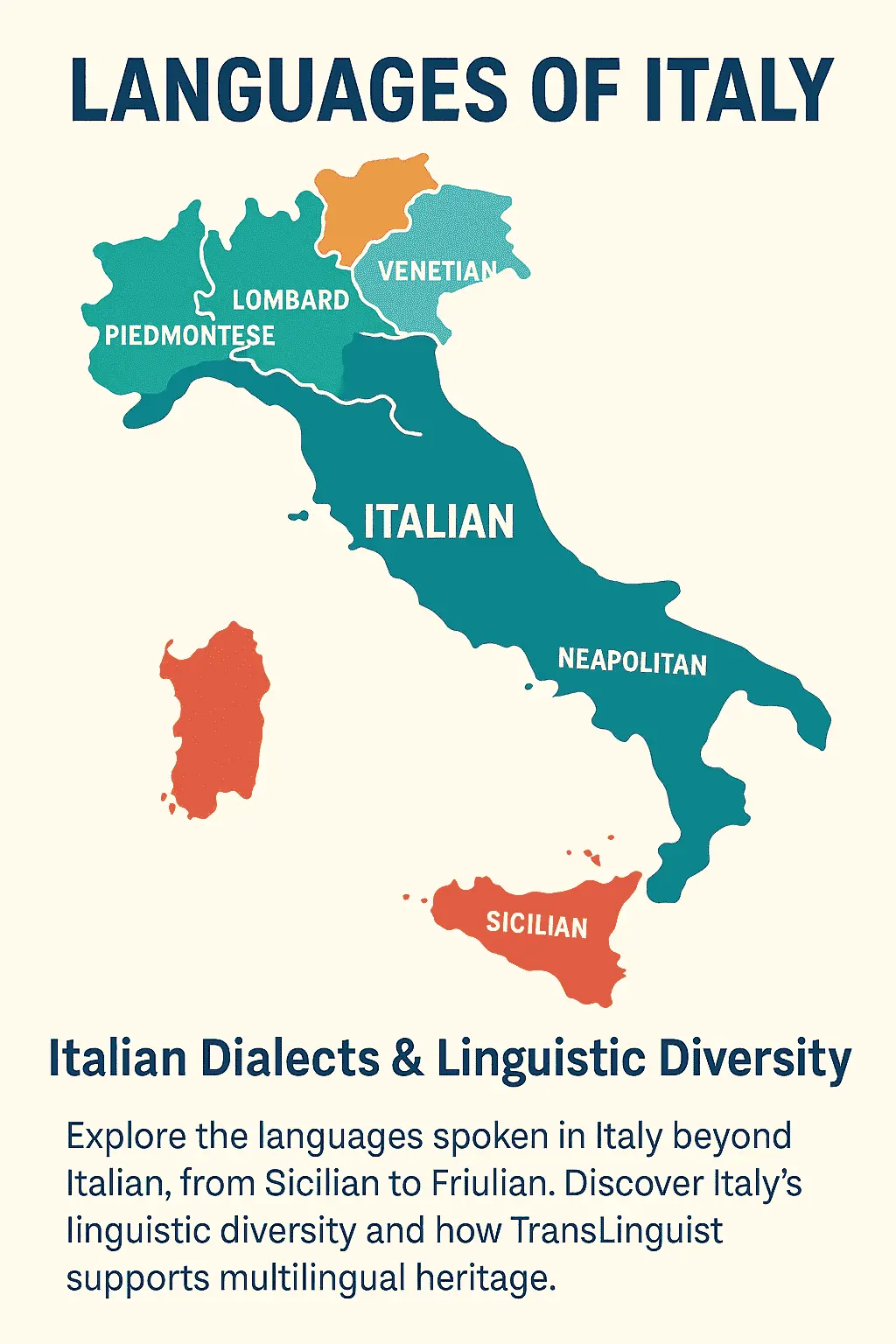Italy is synonymous in the second one’s mind with all imagination recalled to the Italian sweet beat. Italian is, unequivocally, Italy’s most widely spoken and official language, but the full story of the Languages of Italy is considerably more complex and complicated than anybody would ever bother to learn.”
We at TransLinguist boast linguistic diversity at the national and continental levels. Italy, with dozens of languages, local dialects, and personal cultural identities, is a very good example of the intersection of language, history, and culture and how they meet and merge to form a multilingual patchwork.
Italian: The Standard Bearer
Italian, the national language of Italy, is spoken by more than 55 million people. The remainder of Switzerland, Slovenia, Croatia, the Vatican City, and San Marino as well. Standard modern Italian comes from the Tuscan dialect through literature and, particularly, Dante’s Divine Comedy, and subsequently, education and mass media.
And that’s merely half of the “Italian” story.
Outside of Standard: Regional and Indigenous Languages
It has nearly 30 native languages in Italy alone, most of which originated from Vulgar Latin, the common Latin spoken by Roman soldiers and the Romance family. Local languages are not just “dialects” because they have their own grammar, vocabulary, and pronunciation. Some of the most fascinating languages used in Italy today include:
The Neapolitan
Neapolitan (Nnapulitano) is used in Naples and Campania, southern Italy, and by about 7.5 million speakers. Neapolitan is classified as a language under threat by UNESCO and is maintained at home and in the community, but not at the school level. Neapolitan also has a grammar of its own and neuter nouns.
Sicilian (Sicilianu)
Spoken in Latin, Greek, Arabic, Spanish, and others, Sicilian is a spin-off of Sicily’s multilingualism and has some 5 million speakers. Similar to Neapolitan, Sicilian is not secure, but so different as to be spoken nearly like a different language.
Venetian (Veneto)
Also, once an Adriatic language of letters and commerce, Venetian is now spoken in Venice and Veneto. It is still a badge of emigration and conquest in the past, transported as far as Mexican and Brazilian pueblos.
Lombard
Spoken by an estimated 3.5 million in northern Italy and Switzerland, Lombard has Celtic and Germanic substrata. Sadly, UNESCO has labelled it “definitely endangered,” especially in Italy, where it is being displaced.
Piedmontese
Piedmontese is spoken by some two million north-western Italians. It has its origins in medieval literature but is fundamentally dialectical now. It has made little progress in Brazil and Argentina as a result of the inheritance of the previous emigration.
Sardinian
Speakers: 1.5 million speakers on the Sardinian island, the most deviant of the Romance languages.An orally transmitted language, not even written in Sardinia, and unstandardized, with no official status and thus endangered for survival.
Friulian
Friulian is also spoken by over 600,000 people in northern Italy. Despite its inclusion on the list of endangered languages by UNESCO, it’s in a better state than some other indigenous languages because it’s an official language and has the backing of the education system.
What’s the Difference Between Languages and Dialects?
Italian regional dialects will have different words, pronunciation, or grammar when attempting to express the same language. The aforementioned languages have, however, evolved independently for centuries and are linguistically different from Italian. Italian people might comprehend some of them, like Neapolitan or Sicilian, but not others, like Sardinian or Friulian.
Why Is This Important?
We can understand Italy’s magnificent political and cultural past, the Roman period, the Renaissance, the day of unification until today, when we learn that it is multilingual. And that they are much more aware of conservation, education, and language policy of the multilingual population.
TransLinguist makes the celebration and conservation of linguistic heritage easier by offering translation, interpretation, and localisation of culture. Not conversion of languages but a subtle, intellectual, and natural process of communication.
How TransLinguist Supports Multilingualism in Italy
Whether you’re:
- Localizing an Italian brand across dialects,
- Translating museum guides in Sicilian,
- Or adapting legal content into Friulian
TransLinguist helps you navigate linguistic nuances with professionalism and cultural sensitivity. Ready to speak your audience’s language? Get in touch today and unlock the true power of multilingual communication.
FAQs
How many languages are spoken in Italy?
Italy is home to nearly 30 native languages, including both recognized regional languages and minority tongues.
Is Sicilian a dialect or a separate language?
Sicilian is a separate language, not a dialect of Italian. It evolved independently and includes elements from multiple ancient languages.
Which language is most endangered in Italy?
Sardinian is one of the most endangered, as it has no official status, limited educational support, and lacks a standardized form.
Are regional languages taught in Italian schools?
Some languages, like Friulian, have educational backing, but many others, like Lombard and Sardinian, are not taught in schools.
Why should businesses care about Italy's linguistic diversity?
Understanding local languages and dialects helps businesses connect authentically with regional audiences and expand cross-border communication.
Can TransLinguist support translation in regional Italian languages?
Absolutely. Our team works with native linguists from Italy’s diverse regions to offer accurate and culturally appropriate translations.



